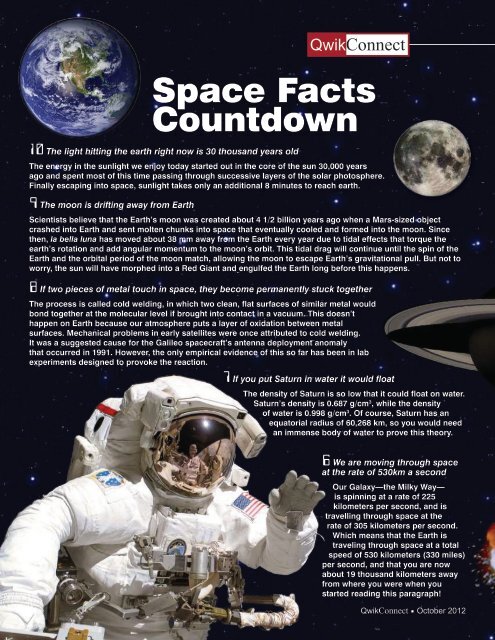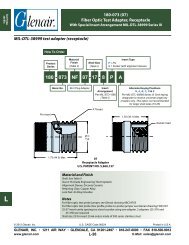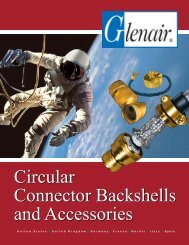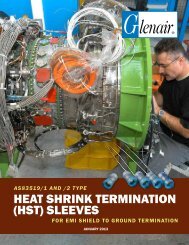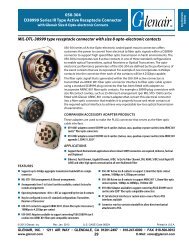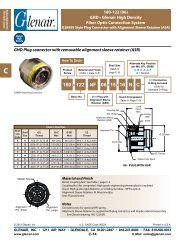Two page spread - Glenair, Inc.
Two page spread - Glenair, Inc.
Two page spread - Glenair, Inc.
You also want an ePaper? Increase the reach of your titles
YUMPU automatically turns print PDFs into web optimized ePapers that Google loves.
QwikConnect<br />
Space Facts<br />
Countdown<br />
10 The light hitting the earth right now is 30 thousand years old<br />
The energy in the sunlight we enjoy today started out in the core of the sun 30,000 years<br />
ago and spent most of this time passing through successive layers of the solar photosphere.<br />
Finally escaping into space, sunlight takes only an additional 8 minutes to reach earth.<br />
9 The moon is drifting away from Earth<br />
Scientists believe that the Earth’s moon was created about 4 1/2 billion years ago when a Mars-sized object<br />
crashed into Earth and sent molten chunks into space that eventually cooled and formed into the moon. Since<br />
then, la bella luna has moved about 38 mm away from the Earth every year due to tidal effects that torque the<br />
earth’s rotation and add angular momentum to the moon’s orbit. This tidal drag will continue until the spin of the<br />
Earth and the orbital period of the moon match, allowing the moon to escape Earth’s gravitational pull. But not to<br />
worry, the sun will have morphed into a Red Giant and engulfed the Earth long before this happens.<br />
8 If two pieces of metal touch in space, they become permanently stuck together<br />
The process is called cold welding, in which two clean, flat surfaces of similar metal would<br />
bond together at the molecular level if brought into contact in a vacuum. This doesn’t<br />
happen on Earth because our atmosphere puts a layer of oxidation between metal<br />
surfaces. Mechanical problems in early satellites were once attributed to cold welding.<br />
It was a suggested cause for the Galileo spacecraft’s antenna deployment anomaly<br />
that occurred in 1991. However, the only empirical evidence of this so far has been in lab<br />
experiments designed to provoke the reaction.<br />
7 If you put Saturn in water it would float<br />
The density of Saturn is so low that it could float on water.<br />
Saturn’s density is 0.687 g/cm 3 , while the density<br />
of water is 0.998 g/cm 3 . Of course, Saturn has an<br />
equatorial radius of 60,268 km, so you would need<br />
an immense body of water to prove this theory.<br />
6 We are moving through space<br />
at the rate of 530km a second<br />
Our Galaxy—the Milky Way—<br />
is spinning at a rate of 225<br />
kilometers per second, and is<br />
travelling through space at the<br />
rate of 305 kilometers per second.<br />
Which means that the Earth is<br />
traveling through space at a total<br />
speed of 530 kilometers (330 miles)<br />
per second, and that you are now<br />
about 19 thousand kilometers away<br />
from where you were when you<br />
started reading this paragraph!<br />
5 Earth has a second moon<br />
Well, not exactly… but there is an asteroid 5km across<br />
whose orbit appears to follow Earth’s. Discovered in<br />
1986 by Duncan Waldron, this periodic planetoid is named<br />
Cruithne (pronounced krin-yə), named after a people of early<br />
medieval Ireland. Because of its 1:1 orbital resonance with<br />
Earth, it is sometimes referred to as Earth’s second moon.<br />
Since its discovery, at least three other similar asteroids have<br />
been discovered. While genuine scientific searches for “second<br />
moons” have been undertaken since the 19th century, all have failed<br />
to confirm a permanent natural satellite… although some still believe in<br />
the astrological second moon Lilith, only visible when it crosses the sun.<br />
4 The Big Dipper is not a constellation<br />
Most people think of the big dipper as a constellation but in fact, it is an asterism. An asterism is a<br />
pattern of stars in the sky which is not one of the official 88 constellations; it can also be composed of<br />
stars from one or more constellations. The Big Dipper is composed entirely of the seven brightest stars<br />
in the Ursa Major (Great Bear) constellation.<br />
3 The Sun is shrinking<br />
A stream of charged particles is being ejected from the surface of the sun. It’s called<br />
Solar wind—the phenomenon that causes the aurora borealis (northern lights)<br />
as well as the tails on comets. The total number of particles carried away<br />
by solar wind is 1.3×10 36 per second, equivalent to the mass of Earth<br />
every 150 million years. But only 0.01% of the Sun’s total mass has<br />
been lost, so it should keep us warm for a while yet.<br />
2 Uranus was originally called George’s Star<br />
Sir William Herschel discovered Uranus in 1781, using a<br />
telescope of his own design. He originally thought it was a comet, but when<br />
astronomers agreed that it was indeed a planet, Herschel was given the honor of<br />
naming it. He chose “Georgium Sidus” (George’s Star) after his new patron, King George III.<br />
Herschel wrote:<br />
“In the fabulous ages of ancient times the appellations of Mercury, Venus, Mars, Jupiter and<br />
Saturn were given to the Planets, as being the names of their principal heroes and divinities.<br />
In the present more philosophical era it would hardly be allowable to have recourse to the same<br />
method… The first consideration of any particular event…seems to be its chronology: if in any future age it<br />
should be asked, when this last-found Planet was discovered It would be a very satisfactory answer to say,<br />
‘In the reign of King George the Third.”<br />
Not surprisingly, this name was not popular outside of Britain. German astronomer Johann Elert<br />
Bode, who determined the orbit of the newly discovered planet, took recourse to the ancient<br />
method and suggested the name Uranus, after the Greek god of the sky.<br />
1 Space is silent<br />
Like the theoretically infinite universe, silence in space is endless. On Earth, sound travels<br />
in waves that vibrate air molecules. But in the vacuum of space there aren’t any molecules to<br />
conduct sound. Even a catastrophic explosion in space would be perfectly silent…and not a<br />
soul would hear your scream.<br />
14 QwikConnect • October 2012 QwikConnect • October 2012<br />
15


